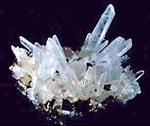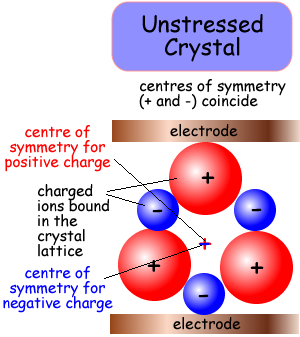The piezoelectric effect

 The piezoelectric effect describes an interchange between mechanical and electrical energy which occurs in certain crystals known as piezoelectric crystals. The piezoelectric effect describes an interchange between mechanical and electrical energy which occurs in certain crystals known as piezoelectric crystals.
Examples of piezo electric cystals - quartz or the synthetic ceramic, lead zirconate titanate. |
 In an unstressed state, the centres of symmetry of both the positive and negative ions of such a crystal lattice coincide. In an unstressed state, the centres of symmetry of both the positive and negative ions of such a crystal lattice coincide.
Therefore no effective charge appears on electrodes attached to either side of the crystal.
The charge is balanced and there is a zero potential difference cross the electrodes.
When the crystal is compressed or stretched and, the centres of symmetry of the charges move apart. They no longer coincide, and give rise to net charge on the electrodes.
Therefore there is a potential difference (voltage) across the electrodes.�Mechanical movement produces an electric field. |
 
|
Applying a voltage to the crystal
If a voltage is applied across an unstressed piezoelectric crystal, the centres of symmetry of the charges move (positive centre towards the negative electrode and vice versa). This deforms the crystal. An applied electric field produces mechanical movement.
An applied alternating voltage gives rise to mechanical vibrations in the crystal.
A maximum response (or resonance) occurs when the applied frequency matches the natural frequency of vibration of the crystal.
If these frequencies of vibration are higher than 20,000 Hz they are in the ultrasonic range. |
| |
Click here to find out how this is used in a piezoelectric transducer.


